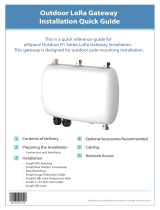The information contained in this document is subject to change. This document contains proprietary information, which is protected by copyright
laws. All rights are reserved. No part of this document may be photocopied, reproduced or translated to another language or program language
without prior written consent of RFI Engineering B.V..
QIG_L-gateway_v1.20 Page: 4(12)
Multi function mounting kit
The multi function mounting bracket mounts on the back of the L-gateway unit housing. The two
ubolts and clamps mount through the four mounting holes on the unit.
2x ubolt, 2x ubolt clamp and 4x M8 nut
2 Safety Warnings
This unit must be installed by a trained professional installer only. Please read all safety warning
before commencing an installation.
Electrical Power Warning
Do not locate any antenna near overhead power lines or other electric light or power circuits, or
where the antenna can come into contact with such circuits. When installing antennas, take
extreme care not to come into contact with such electrical circuits, as they can cause serious
injury or death.
A safe grounding system is necessary to protect your L-gateway from lightning strikes and the
build-up of static electricity when installed in an outside environment. Direct grounding of the
antenna mast and L-gateway is important. When mounting the L-gateway to an antenna mast,
you have to connect the L-gateway to the same grounding system with the AC wall outlet.
The grounding system must comply with the National Electrical Code and safety standards that
apply in your country. Always check with a qualified electrician if you are in doubt as to whether
your outdoor installation is properly grounded.
Lightning Activity Warning
Do not work on the system or connect or disconnect cables during periods of lightning activity.
The L-gateway is designed to be installed in an outdoor environment, typically on a tower or a
tall building. Plan your installation carefully and completely before you begin. Do not work on a
wet or windy day. Do dress properly, use shoes with rubber soles and heels, long sleeved shirts
or jackets to avoid the risk of coming in contact with live mains wiring.















